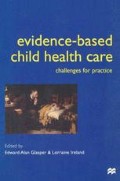Abstract
Our ability to assess practice at degree level is just as crucial as our ability to assess theory. What, it is suggested, differentiates degree-level practice is the intellectual process associated with the practice in question. A key element of the effective assessment of practice is that evidence must be collected from a range of sources. Examples of such sources that have been exploited within a programme of study are discussed, including critical incident analysis, commentary in practice, prescribed specific outcomes, the documentation of care, the observation of practice, written evidence, spontaneous discussions of practice, and extracts from a reflective diary. The process of providing and evaluating the evidence was conducted within a tripartite arrangement involving the practitioner or student, the supervising practitioner and a lecturer. The net result was an overall assessment of the degree of competence.
Preview
Unable to display preview. Download preview PDF.
References
Akinsanya J. (1993) ‘Preparation of nurse teachers: a rethink’, Nursing Standard 8 (5): 28–30.
Benner P. (1984) From Novice to Expert: Excellence and Power in Clinical Nursing Practice, Menlo Park, CA, Addison-Wesley.
Clark J. (1992) ‘Nursing: an intellectual activity’, International Nursing Review 39 (2): 60.
Commission of the European Communities (1989) Nursing Education in the 21st Century, proceedings of a symposium. Brussels, CEC.
Corcoran S., Narayan S. and Moreland H. (1988) ‘“Thinking aloud” as a strategy to improve clinical decision making’, Heart Lung 17: 463–8.
Council of Europe (1994) Working Party on the Role and Education of Nurses, CDSP (94): 35, Strasbourg. Council of Europe.
Davis B. and Burnard, P. (1992) ‘Academic levels in nursing’, Journal of Advanced Nursing 17: 1395–400.
Department of Health (1997) A Bridge to the Future: Nursing Standards, Education and Workforce Planning in Paediatric Intensive Care, London, HMSO.
Elliot P. (1993) ‘Locality based teaching’, Senior Nurse 13 (2): 35–9.
English National Board for Nursing, Midwifery and Health Visiting (1993) Assessment of Competencies in Nursing and Midwifery Education and Training (the ACE Project), London, ENB.
English National Board for Nursing, Midwifery and Health Visiting (1994) Creating Lifelong Learners–Partnerships for Care London, ENB.
Flanagan J. (1954) ‘The critical incident technique’, Psychological Bulletin 51(4): 327–58.
Fonteyn M. E. and Fisher A. (1995) ‘Use of think aloud method to study nurse decision making in clinical practice settings’, Journal of Neuroscience Nursing 27 (2): 121–6.
Fonteyn M. E., Kuipers B. and Grobe S. J. (1993) ‘A description of think aloud method and protocol analysis’, Qualitative Health Research 3 (4): 430–40.
Goding L. (1997) ‘Can degree level practice be assessed?’, Nurse Education Today 17 (2): 158–61.
Hahnemann B. (1986) ‘Journal writing: a key to promoting critical thinking in nursing students’, Journal of Nursing Education 25: 213–15.
Hammersley M. and Atkinson P. (1995) Ethnography: Principles in Practice ( 2nd edn ), Routledge, London.
International Council of Nurses (1989) Development of Standards for Nursing Education and Practice: Guidelines for National Nurses Associations, Geneva, ICN.
Jolley M. and Allen P. (1991) Current Issues in Nursing, London, Chapman & Hall.
Long P. (1976) ‘Judging and reporting on student nurse clinical performance: some problems for the ward sister’, International Journal of Nursing Studies 13: 115–21.
Lyte V. and Thompson I. (1990) ‘The diary as a formative teaching and learning aid incorporating means of evaluation and renegotiation of clinical learning objectives’, Nurse Education Today 10: 228–32.
NHS Executive (1996) Promoting Clinical Effectiveness: A Framework for Action in and through the NHS, London, DoH.
NHS Executive (1997) The New NHS: Modern, Dependable, Cmnd 3807, London, DoH.
NHS Executive (1998a) Integrating Theory and Practice in Nursing, London, DoH.
NHS Executive (1998b) A First Class Service, London, DoH.
Richardson G. and Hendrika M. (1995) ‘Reflection-on-practice: enhancing student learning’, Journal of Advanced Nursing 22 (2): 235–42.
Royal College of Nursing (1996) A Principled Approach to Nurse Education, London, RCN.
Schön D. (1987) Educating the Reflective Practitioner: Towards a New Design for Teaching and Learning in the Professions, London, Falmer.
United Kingdom Central Council for Nursing Midwifery and Health Visiting (1994) The Future of Professional Practice–The Council’s Standards for Education and Practice Following Registration, London, UKCC.
Wong J. (1979) ‘The inability to transfer classroom learning to clinical nursing practice: a learning problem and its remedial plan’, Journal of Advanced Nursing 4 (2): 161–8.
Further reading
English National Board for Nursing Midwifery and Health Visiting (1993) A Detailed Study of the Relationships between Teaching, Support, Supervision and Role Modelling for Students in Clinical Areas, within the Context of Project 2000 Courses, Research Highlights 3, London, ENB.
English National Board for Nursing, Midwifery and Health Visiting (1994) Researching Professional Education: Education, Dialogue and Assessment: Creating Partnership for Improving Practice, London, ENB.
Editor information
Editors and Affiliations
Copyright information
© 2000 The Editor(s)
About this chapter
Cite this chapter
Long, T., Asbury, J. (2000). Demonstrating evidence-based clinical nursing practice: providing the evidence. In: Glasper, E.A., Ireland, L. (eds) Evidence-based Child Health Care. Palgrave, London. https://doi.org/10.1007/978-0-333-98239-6_2
Download citation
DOI: https://doi.org/10.1007/978-0-333-98239-6_2
Publisher Name: Palgrave, London
Print ISBN: 978-0-333-80230-4
Online ISBN: 978-0-333-98239-6
eBook Packages: MedicineMedicine (R0)

